How Long Did The Industrial Revolution Last
The Industrial Revolution took place from the eighteenth century up until the mid-nineteenth century, marking a process of increased manufacturing and product which boosted industry and encouraged new inventions ad innovations.
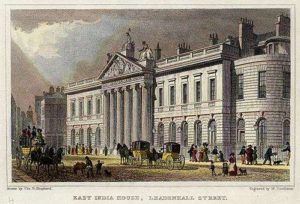 Headquarters of the East India Company, London, 1828
Headquarters of the East India Company, London, 1828
1600- The germination of the East India Company. The joint-stock visitor would later play a vital part in maintaining a trade monopoly that helped increment need, production and profit. The company helped Britain compete with its European neighbours and grow in economic and trading force.
1709- Abraham Darby leases the furnace which he successfully uses for the first fourth dimension. Darby was able to sell 81 tons of fe goods that year. He would become a crucial figure in industry, discovering a method of producing squealer iron fuelled past coke rather than charcoal.
1712- Thomas Newcomen invents the first steam engine.
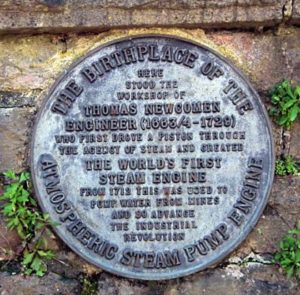
1719- The silk mill is started by John Lombe. Located in Derbyshire, Lombe's Factory opens every bit a silk throwing manufactory, the first successful one of its kind in England.
1733- The uncomplicated weaving machine is invented by John Kay known as the Flying Shuttle. The new invention allowed for automatic car looms which could weave wider fabrics and speed upward the manufacturing procedure.
1750- Cotton wool cloths were being produced using the raw cotton imported from overseas. Cotton exports would help make Britain a commercial success.
1761- The Bridgewater Canal opens, the showtime of its kind in Britain. It was named later Francis Egerton, third Duke of Bridgewater who commissioned it in order to transport the coal from his mines in Worsley.
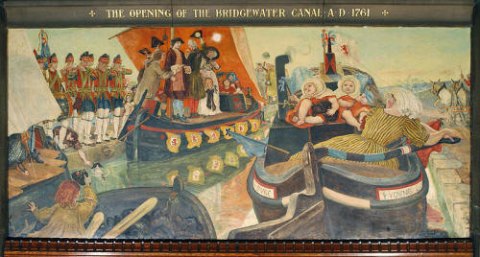
1764- The invention of the Spinning Jenny by James Hargreaves in Lancashire. The idea consisted of a metal frame with viii wooden spindles. The invention immune the workers to produce cloth much quicker thus increasing productivity and paving the manner for farther mechanisation.
1764- Scottish inventor James Watt is commissioned to comport out repairs to a Thomas Newcomen steam engine and apace recognises ways that it tin can be modified to operate much more efficiently. By changing the way the cylinder was heated and cooled the amount of coal used in heating the water to produce the steam could be reduced by more 60%.
1769- James Watt was granted his first British patent (No. 913) for the unique pattern of his new steam engine. To quantify the enormous power of his new engines, James Watt also invented a new unit of measurement: The Horsepower. James Watt'south steam engines would literally fix the world in motility… through the introduction of steam powered railway locomotives and steam ships… transportation would be completely revolutionised. His steam engines would also proceed to power the new mills that were starting to appear in the Industrial North.
1769- The yarn produced by the new Spinning Jenny was not particularly strong but this soon changed when Richard Arkwright invented the h2o frame which could attach the spinning auto to a water wheel.
1774- The English inventor Samuel Crompton invented the Spinning Mule which would combine the processes of spinning and weaving into one motorcar, thus revolutionising the industry.
1779- The inventor Richard Arkwright became an entrepreneur and opened a cotton spinning mill using his invention of the water frame.
1784- The ironmaster, Henry Cort came up with the idea for a puddling furnace in order to make fe. This involved making bar iron with a reverberating furnace stirred with rods. His invention proved successful for fe refining techniques.
1785- The power loom was invented, designed the previous twelvemonth past Edmund Cartwright, who later on patented the mechanised loom which used h2o to increase the productivity of the weaving process. His ideas would be shaped and developed throughout the years in order to create an automatic loom for the textile manufacture.
1790- Edmund Cartwright produced some other invention called a wool combing machine. He patented the invention which arranged the fibres of wool.
1799- The Combination Act received purple assent in July, preventing workers in England collectively bargaining in groups or through unions for better pay and improved working conditions. In the aforementioned year, on the 9th October a group of English textile workers in Manchester rebelled against the introduction of mechanism which threatened their skilled craft. This was 1 of the initial riots that would occur under the Luddite movement.
1800- Effectually x one thousand thousand tons of coal had been mined in United kingdom.
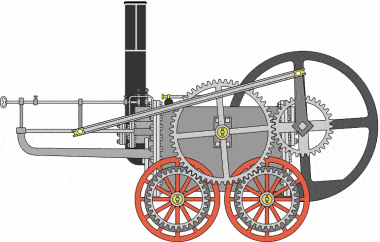 The Trevithick locomotive
The Trevithick locomotive
1801- Richard Trevithick, a mining engineer and inventor drove a steam powered locomotive down the streets of Camborne in Cornwall. He was a pioneer of steam-powered transport and built the starting time working railway locomotive.
1803- Cotton becomes Britain'due south biggest consign, overtaking wool.
1804- The outset locomotive railway journey took place in Feb, the Trevithick invention successfully hauled a railroad train forth a tramway in Merthyr Tydfil.
1811- The first large-scale Luddite riot took place in Arnold, Nottingham resulting in the destruction of machinery.
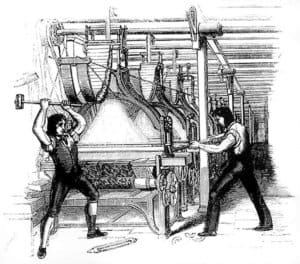
1812- In response to the riots, Parliament passed a police force making the devastation of industrial machines punishable by expiry.
1813- In a one 24-hour interval trial, 14 Luddites were hanged in Manchester.
1815- Cornish chemist Sir Humphrey Davy and English engineer George Stephenson both invented prophylactic lamps for miners.
1816- The engineer George Stephenson patented the steam engine locomotive which would earn him the title of "Father of the Railways".
1824- The repeal of the Combination Human activity which was believed to have acquired irritation, discontent and gave rising to violence.
1825: The starting time passenger railway opens with Locomotion No.1 conveying passengers on a public line.
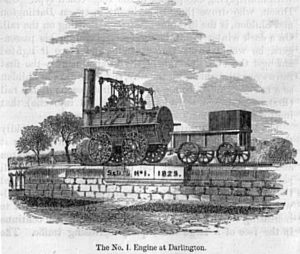
1830- George Stephenson created the beginning public inter-city rail line in the world connecting the keen northern cities of Manchester and Liverpool. The industrial powerhouse and landlocked city of Manchester could now speedily admission the world through the Port Of Liverpool. Cotton arriving from plantations in America would supply the textile mills of Manchester and Lancashire, with the finished cloth returned to Liverpool and exported throughout the British Empire.
1833- The Factory Act is passed to protect children under the age of nine from working in the textile industry. Children aged thirteen and over could not piece of work longer than sixty nine hours a week.
1834 – The Poor Law was passed in society to create workhouses for the destitute.
1839- James Nasmyth invents the steam hammer, built to meet the need for shaping large fe and steel components.
1842- A law applied to miners, banning children under the age of ten too as women from working clandestine.
1844- The law states children younger than eight are banned from working. In the same yr Friedrich Engels publishes his observations of the touch of the industrial revolution in "The Condition of the Working Class in England".
1847- New law stating express working hours of women and children in cloth factories to 10 hours a day.
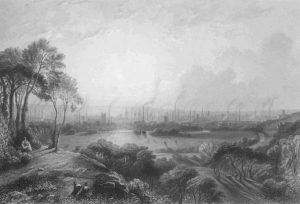 Manchester – 'Cottonopolis' – in 1840
Manchester – 'Cottonopolis' – in 1840
1848- The impact of industrialisation and cosmos of cities leads to a cholera epidemic across towns in United kingdom.
1851-Rural to urban migration results in over half the population of Britain now residing in towns.
1852- The British shipbuilding company Palmer Brothers & Co opens in Jarrow. The aforementioned year, the start iron screw collier, the John Bowes is launched.
1860- The first iron warship, HMS Warrior is launched.
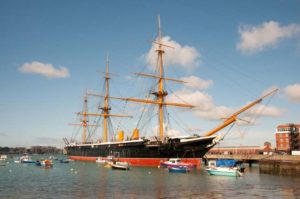 HMS Warrior, at present a museum ship in Portsmouth
HMS Warrior, at present a museum ship in Portsmouth
1867- The Manufacturing plant Act is extended to include all workplaces employing more than than 50 workers.
1868- The TUC (Merchandise Unions Congress) is formed.
1870- Forster'south Education Act which takes the starting time tentative steps at enforcing compulsory teaching.
1875- New law prohibited boys from climbing chimneys to clean them.
1912- The industry of Britain reaches its peak, with the textile industry producing around 8 billion yards of fabric.
1914- World War One changes the industrial heartlands, with strange markets setting up their own manufacturing industries. The golden age of British manufacture has come up to an end.
The sequence of events placed Britain equally a major role player on the global stage of merchandise and manufacturing, allowing information technology to go a leading commercial nation as well every bit marking a huge turning point in United kingdom of great britain and northern ireland's social and economic history.
Jessica Brain is a freelance writer specialising in history. Based in Kent and a lover of all things historical.
Source: https://www.historic-uk.com/HistoryUK/HistoryofBritain/Timeline-Industrial-Revolution/
Posted by: petersonandere.blogspot.com






0 Response to "How Long Did The Industrial Revolution Last"
Post a Comment